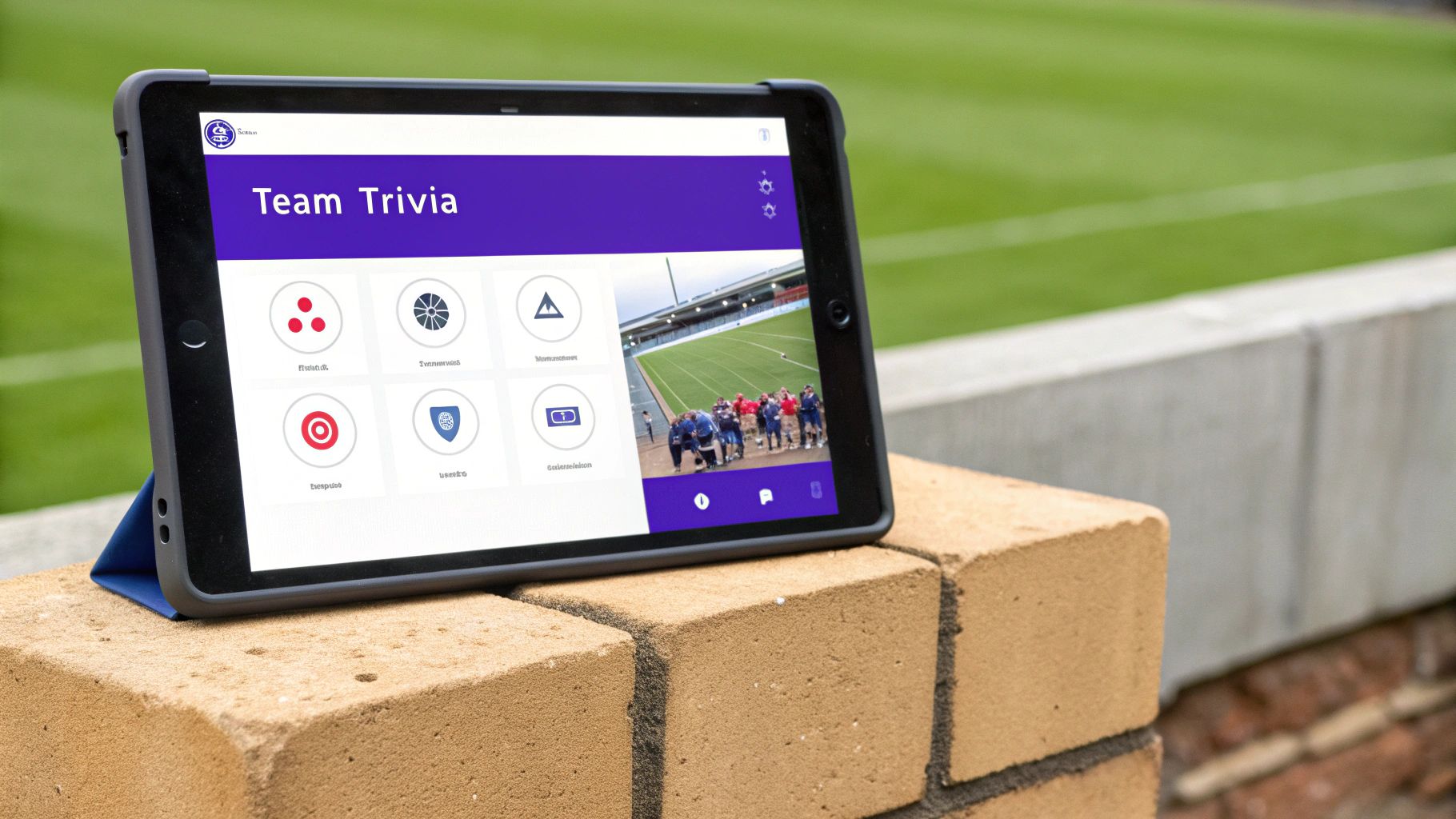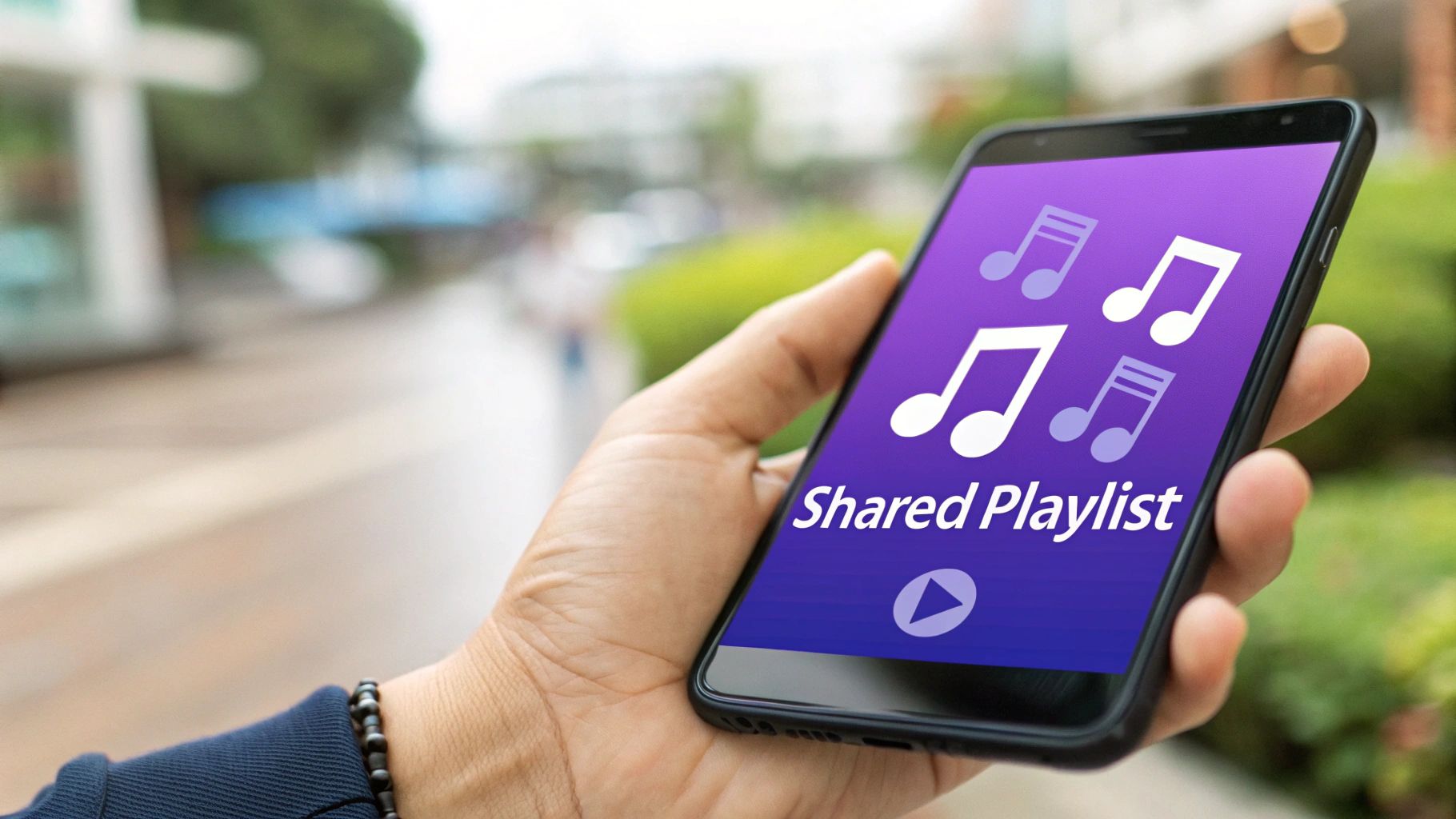Working remotely doesn't mean working in isolation. As companies adapt to new work models, the need for genuine team connection has become a critical factor for success, influencing everything from morale and productivity to employee retention. For a deeper dive into the current state of flexible work models, explore insights on the evolving landscape of remote work. The challenge is clear: how do you build a strong, collaborative culture when your team is distributed across different locations?
The answer lies in creating intentional opportunities for interaction that go beyond status updates and project meetings. This requires a thoughtful approach to virtual team engagement activities that are both fun and meaningful. Forget awkward video calls and forced fun; the goal is to foster authentic relationships and a shared sense of purpose. This shift from simple virtual meetings to engaging shared experiences is what transforms a group of remote workers into a cohesive and high-performing team.
This guide provides a practical list of proven activities designed to energize your remote workforce. We will explore specific, actionable ideas you can implement immediately, from collaborative problem-solving in virtual escape rooms to casual chats over coffee. Each item includes clear steps for execution and tips on how to facilitate the experience for maximum impact, helping you build a connected and thriving virtual team.
1. Virtual Escape Rooms
Virtual escape rooms are one of the most immersive and exciting virtual team engagement activities available. In these online games, your team collaborates to solve a series of puzzles and riddles within a set time limit, all centered around a specific theme. The goal is to "escape" a digital room by combining logic, communication, and creative thinking. This activity directly challenges a team's ability to communicate clearly and delegate tasks under pressure.

This type of activity is perfect for teams that need to improve their collaborative problem-solving skills in a fun, low-stakes environment. Companies like Microsoft and Salesforce use services from providers such as The Escape Game and Breakout Games to foster teamwork and boost morale. These platforms offer a range of themes, from spy thrillers to historical mysteries, ensuring there is something for every team culture.
How to Implement a Virtual Escape Room
To get the most out of this experience, follow a few simple steps. First, select a theme and difficulty level that matches your team's personality and experience. It's better to start with an easier room to build confidence.
- Prepare Your Team: Send out instructions and any necessary links well in advance. Make sure everyone understands the technology requirements, like needing a specific browser or a stable internet connection.
- Divide and Conquer: If you have a large team (more than 8-10 people), break them into smaller groups. This encourages more active participation from every individual and can add a fun competitive element.
- Facilitate a Debrief: After the game ends, hold a short discussion. Ask questions like, "What was our biggest communication challenge?" or "Who stepped up to lead at a critical moment?" This reflection turns a fun game into a valuable learning experience.
Key Insight: The true value of a virtual escape room isn't just in solving the puzzles; it's in observing how your team communicates and collaborates under a time constraint.
This activity is a fantastic way to break the monotony of daily work and see your colleagues in a new light. For teams looking for a structured and engaging challenge, it is an excellent choice. You can find more details in this great list of virtual team building activities.
2. Virtual Coffee Chats and Speed Networking
Virtual coffee chats and speed networking sessions are simple yet powerful virtual team engagement activities designed to replicate the spontaneous "water cooler" moments that remote teams often miss. These structured but informal conversations involve randomly pairing or grouping team members for short, timed discussions. The primary goal is to foster personal connections and build cross-departmental relationships that might not otherwise form in a remote setting. This activity strengthens the social fabric of a team by encouraging non-work-related interactions.

This approach is perfect for teams looking to combat feelings of isolation and improve company-wide camaraderie in a low-pressure way. Companies like Spotify and Buffer use tools such as the Donut Slack app to automatically pair employees for random chats, making it a seamless part of their remote culture. These sessions are highly effective for onboarding new hires, helping them quickly build a network and feel integrated into the team.
How to Implement Virtual Coffee Chats
To ensure these sessions are effective and enjoyable, a little bit of structure goes a long way. First, decide on the format, whether it’s one-on-one pairings or small group speed networking in breakout rooms.
- Provide Conversation Starters: Prepare a list of light-hearted questions that mix personal and professional topics to avoid awkward silences. This is one of the easiest ways to implement some great virtual team icebreakers.
- Keep it Voluntary: Make participation optional to ensure the interactions feel genuine rather than forced. This maintains the casual, social nature of the activity.
- Facilitate Smooth Transitions: Use the breakout room feature in your video conferencing tool to automatically manage pairings and timing. Announce time warnings before bringing everyone back to the main session.
Key Insight: The success of virtual coffee chats lies in their consistency and low-effort nature. Making them a regular, easy-to-join ritual helps build the social connections that are vital for a strong, cohesive remote team.
This activity is a fantastic tool for humanizing the virtual workspace and strengthening interpersonal bonds. For teams aiming to build a more connected and supportive culture, it is an essential practice.
3. Online Team Trivia and Quiz Games
Online team trivia and quiz games are a classic and highly effective way to foster friendly competition and camaraderie. These interactive knowledge-based competitions challenge teams to answer questions across various categories, turning a standard video call into an engaging and lively event. The goal is to create a fun, competitive atmosphere that encourages teamwork and helps colleagues connect on a personal level. This activity is a fantastic tool for reinforcing company culture and shared knowledge.

This type of activity is ideal for teams of any size and requires minimal setup, making it one of the most accessible virtual team engagement activities. Companies like IBM and Deloitte use platforms such as Kahoot! and Quizizz for everything from training reinforcement to casual team-building sessions. These tools allow for custom quizzes, including company-specific trivia or questions about teammates, which helps strengthen personal bonds in a remote setting.
How to Implement Online Team Trivia and Quiz Games
To host a successful trivia session, a little preparation goes a long way. First, choose a platform and decide on the quiz format and theme. A mix of topics usually keeps things interesting for everyone.
- Curate Your Questions: Create a balanced mix of easy and challenging questions. Include themed rounds related to your industry, pop culture, or even inside jokes specific to your team. Incorporating multimedia elements like images and audio clips can make it more dynamic.
- Encourage Participation: Consider offering small prizes or recognition for the winning team, but also celebrate participation to keep the focus on fun rather than just winning. This ensures a positive experience for all involved.
- Test Everything First: Do a quick run-through of the technology before the event. Make sure everyone knows how to join and that any links or software work as expected. Having a backup plan is always a good idea.
Key Insight: The most impactful trivia games often include questions about team members themselves. This simple addition transforms a general knowledge quiz into a powerful tool for building personal connections.
This activity is a superb choice for a quick morale boost or a fun way to end a busy week. For teams seeking a low-pressure, high-energy way to interact, it is an excellent option. You can get more inspiration from this list of icebreaker quiz questions.
4. Virtual Cooking or Cocktail Classes
Virtual cooking or cocktail classes are fantastic virtual team engagement activities that allow colleagues to bond over a shared, hands-on experience. In these sessions, a professional chef or mixologist guides your team through creating a specific dish or drink via a live video call. Everyone follows along from their own kitchen, creating a relaxed, social atmosphere that encourages casual conversation and shared accomplishment. This activity breaks down formal barriers and lets team members connect on a more personal level.

This format is ideal for teams looking to unwind and celebrate milestones in a creative way. Companies like Airbnb and Uber have used platforms such as Cozymeal to host interactive culinary events, while others, like Shopify, have hired local bartenders for private virtual cocktail-making classes. The shared experience of creating (and enjoying) something delicious together fosters a strong sense of community and camaraderie, even across different time zones.
How to Implement a Virtual Cooking or Cocktail Class
To ensure your culinary event is a success, thoughtful planning is key. The goal is to make it as easy and enjoyable as possible for everyone to participate.
- Plan the Logistics: Send out the recipe and ingredient list well in advance. For ultimate convenience, consider using a service that delivers pre-portioned ingredient kits directly to each team member's home.
- Accommodate Everyone: Choose a recipe that is beginner-friendly and offer alternatives for dietary restrictions (e.g., non-alcoholic mocktails or vegetarian options). This inclusivity ensures everyone feels valued and can participate fully.
- Encourage Social Sharing: Create a dedicated chat channel where team members can share photos of their creations, both during and after the class. This extends the fun and allows for more interaction.
Key Insight: The focus of a virtual cooking class is less on the culinary perfection and more on the shared experience. Laughter over a spilled ingredient or a slightly burnt dish often creates the most memorable bonding moments.
This activity is a wonderful way to engage the senses and create a tangible, shared outcome. It provides a much-needed break from screens and spreadsheets, making it a refreshing choice for any remote team.
5. Online Game Tournaments (Multiplayer Games)
Organized competitive gaming events are a fantastic way to introduce ongoing, friendly rivalry and engagement. In these tournaments, teams compete in brackets or leagues using accessible online multiplayer games. This activity builds a sense of community and sustained excitement as colleagues root for each other, practice together, and celebrate victories. It’s a powerful method for fostering informal connections and consistent team interaction.
This type of activity is ideal for teams seeking to build camaraderie over a longer period, rather than a single event. Tech companies often organize Among Us tournaments to promote strategic communication, while companies like Netflix have participated in corporate chess tournaments on Chess.com. Platforms like Discord and Steam make it easy to coordinate these events, creating a dedicated space for fun outside of the typical work environment.
How to Implement an Online Game Tournament
A successful tournament requires more than just picking a game. First, select games that are easy to learn but offer depth, ensuring both new and experienced players can participate and have fun.
- Choose Accessible Games: Start with games like Fall Guys or browser-based options that don't require high-end computers. Rotate games periodically to cater to different interests and skill sets.
- Establish Clear Rules: Create and share a clear rulebook covering fair play, scheduling, and tournament structure. Consider creating different tiers or brackets to accommodate various skill levels, making it competitive for everyone.
- Encourage Team-Based Play: Whenever possible, opt for team-based games like Rocket League. This shifts the focus from individual skill to collaborative strategy, directly enhancing teamwork and communication.
- Offer Practice Sessions: Host optional tutorials or practice rounds before the tournament begins. This helps level the playing field and ensures everyone feels comfortable with the game mechanics before competing.
Key Insight: A well-organized tournament is less about winning and more about creating a shared experience. The ongoing chatter, team strategizing, and friendly banter are what truly build lasting team bonds.
This is one of the most effective virtual team engagement activities for creating a vibrant and connected remote culture. You can discover more ideas in this detailed guide to virtual employee engagement activities.
6. Virtual Show and Tell Sessions
Virtual show and tell sessions are a simple yet powerful way to foster personal connections among remote colleagues. In these scheduled meetings, team members take turns sharing something meaningful from their personal lives, such as a hobby, a unique collection, a beloved pet, or even a recent non-work-related project. This activity offers a rare glimpse into the personalities and passions of teammates beyond their professional roles, humanizing the virtual workspace.
This type of activity is ideal for teams looking to build psychological safety and a more inclusive, tight-knit culture. Companies known for their strong remote cultures, like Basecamp and Zapier, use similar formats to encourage personal sharing and strengthen bonds. These sessions can range from introducing pets on camera to presenting a short slideshow on a niche hobby, making it one of the most adaptable virtual team engagement activities available.
How to Implement Virtual Show and Tell Sessions
To ensure your show and tell is engaging and comfortable for everyone, a little structure goes a long way. Start by establishing it as a recurring, low-pressure event.
- Set Clear Guidelines: Create a safe space by providing clear guidelines on appropriate topics. Encourage sharing that is personal but professional, and make participation voluntary.
- Keep it Brief and Consistent: Limit each person's sharing time to 5-10 minutes to keep the session dynamic and ensure multiple people can present. A short Q&A after each share encourages interaction.
- Provide Prompts: For team members who might be nervous or unsure what to share, offer a list of prompts. Ideas could include "your favorite WFH gadget," "a book that changed your perspective," or "your proudest DIY project."
- Facilitate Connections: After the session, help connect team members with shared interests. For example, if two people discover they both love gardening, you could create a dedicated chat channel for them to continue the conversation.
Key Insight: The goal of show and tell is not to impress but to connect. It creates shared experiences and uncovers common ground that strengthens team cohesion far beyond the meeting itself.
This activity is a fantastic way to cultivate empathy and understanding within a distributed team. It requires minimal resources and can be easily integrated into a weekly or monthly team meeting.
7. Collaborative Playlist Building
Collaborative playlist building is a simple yet powerful way to connect team members on a personal level through the universal language of music. This activity involves creating a shared playlist where each person adds songs based on a specific theme, mood, or memory. It’s a low-effort, high-impact method for discovering common interests and celebrating the diverse tastes within your team.
This type of activity is perfect for ongoing, passive engagement that helps build a sense of shared culture. Companies leverage platforms like Spotify and Apple Music to create playlists for different work modes, such as "Deep Focus" or "Friday Wind-Down." It’s a fantastic way to subtly integrate team personality into the remote work environment, making the virtual space feel more connected and human.
How to Implement Collaborative Playlist Building
To launch this activity successfully, a little structure goes a long way. Start with a clear theme to guide contributions and encourage participation.
- Set a Theme and Guidelines: Choose a theme like "Productivity Boosters," "Songs from High School," or "Vacation Vibes." It's also wise to set basic guidelines on explicit content to maintain a professional and inclusive atmosphere.
- Encourage Sharing: Ask team members to share a brief note about why they chose a particular song. This adds a storytelling element that fosters deeper connections and sparks conversations in your team's chat channel.
- Use the Playlists: Don't just build the playlists and forget them. Play them as background music during virtual happy hours, collaborative work sessions, or before all-hands meetings to set the mood. You can find more playlist ideas in this guide to music-themed team activities.
Key Insight: A shared playlist is more than just a collection of songs; it’s a living document of your team's collective personality, memories, and mood.
This is one of the most accessible virtual team engagement activities, as it can run in the background without disrupting workflows. It provides a continuous, low-pressure opportunity for team members to express themselves and connect with colleagues.
8. Virtual Talent Shows or Open Mic Sessions
Virtual talent shows or open mic sessions are performance-based events where team members voluntarily showcase their unique skills. This can include singing, playing an instrument, stand-up comedy, poetry, magic tricks, or any other creative talent. These events celebrate individual creativity, build personal connections, and foster a culture of appreciation for the diverse abilities within the team.
This type of activity is ideal for humanizing the virtual workplace and allowing colleagues to see each other beyond their professional roles. Companies like HubSpot and Buffer have successfully used virtual creative showcases to boost morale and highlight the unique personalities on their teams. These virtual team engagement activities provide a refreshing break from work-related discussions and build a strong sense of community.
How to Implement a Virtual Talent Show
To host a successful and inclusive event, careful planning is key. The focus should be on fun and participation, not professional-level performance.
- Make it Voluntary and Inclusive: Emphasize that participation is completely optional and pressure-free. Allow for various formats, including live performances, pre-recorded videos, or even sharing digital artwork.
- Provide Technical Support: Before the event, offer a quick tech check for performers to test their audio and video setup. A designated host can help manage transitions between acts smoothly.
- Foster a Supportive Atmosphere: Set clear guidelines for the audience to be positive and encouraging. The goal is to celebrate courage and creativity, so all forms of participation should be met with applause and positive feedback.
Key Insight: A virtual talent show's success is measured by the supportive atmosphere and laughter it creates, not the quality of the performances. It’s a powerful tool for revealing the hidden, human side of your team members.
This activity is a fantastic way to inject personality and fun into your remote culture. For teams looking to build deeper, more personal bonds, it's an excellent choice. You can discover more engagement ideas like this in this guide to remote team engagement.
Virtual Team Engagement Activities Comparison
| Activity | Implementation Complexity 🔄 | Resource Requirements ⚡ | Expected Outcomes 📊 | Ideal Use Cases 💡 | Key Advantages ⭐ |
|---|---|---|---|---|---|
| Virtual Escape Rooms | Medium to high (digital setup, facilitation) | Moderate (tech, game masters, stable internet) | Strong team problem-solving & collaboration | Teams needing problem-solving & communication | Builds critical thinking, customizable, engaging |
| Virtual Coffee Chats & Speed Networking | Low (simple setup, video tools) | Low (video conferencing, prompts) | Improved personal connections & cross-team bonds | Remote teams requiring informal networking | Easy, low cost, frequent relationship building |
| Online Team Trivia & Quiz Games | Medium (question prep, scoring systems) | Low to moderate (quiz platforms, host) | Fun competitive engagement, knowledge sharing | Large groups, educational & culture-building | Highly engaging, customizable, scalable |
| Virtual Cooking or Cocktail Classes | High (preparation, ingredients, instructor) | Moderate to high (professional instructors, ingredients) | Relaxed socializing, shared tangible experiences | Teams wanting casual, social events | Memorable, skill inclusive, cultural exchange |
| Online Game Tournaments (Multiplayer Games) | Medium to high (game setup, brackets) | Moderate (game licenses, streaming) | Ongoing engagement, friendly competition | Competitive teams, ongoing team engagement | Builds team spirit, multiple skill levels |
| Virtual Show and Tell Sessions | Low (volunteer coordination, scheduling) | Very low (video tools, presentations) | Personal connections, empathy, talent discovery | Teams seeking personal sharing & bonding | Easy to organize, builds empathy & inclusion |
| Collaborative Playlist Building | Very low (playlist setup, curation) | Very low (streaming subscriptions) | Shared resources, cultural insights, casual bonding | Teams wanting ongoing low-effort engagement | Low cost, ongoing interest, inclusive |
| Virtual Talent Shows or Open Mic Sessions | Medium (volunteer coordination, tech) | Low to moderate (video/audio setup) | Celebrated creativity, team morale boost | Creative, morale-boosting, entertainment focus | Builds confidence, memorable, celebrates diversity |
From Activity to Action: Building Engagement into Your Team's DNA
We've explored a vibrant collection of virtual team engagement activities, from the strategic thrill of an escape room to the relaxed camaraderie of a collaborative playlist. Each idea, whether it’s a high-energy game tournament or a personal show-and-tell session, offers a unique pathway to stronger team bonds. But the real magic isn't in just doing these activities; it's in what they build.
The goal is to transform one-off events into a sustained culture of connection. These aren't just breaks from work; they are strategic investments in your team’s psychological safety, trust, and communication. A team that laughs together over a trivia quiz is more likely to navigate a difficult project with empathy and mutual respect.
Key Takeaways for Lasting Impact
Moving forward, the challenge is to weave engagement into the very fabric of your remote workflow. It’s about creating a system where connection is a feature, not a bug.
- Consistency Over Intensity: A regular, 15-minute virtual coffee chat can be more impactful than a single, extravagant annual event. Aim for a consistent rhythm of connection that your team can anticipate and rely on.
- Empower Team Champions: You don't have to orchestrate everything yourself. Identify enthusiastic team members who can lead an activity, like organizing a game tournament or a virtual book club. This creates ownership and diversifies your engagement efforts.
- Tie Fun to Function: The most powerful virtual team engagement activities subtly reinforce skills needed for work. Collaborative games build problem-solving abilities, while open-mic sessions enhance presentation confidence. Recognize these dual benefits.
- Integrate, Don't Isolate: True engagement happens when these practices are supported by your daily operations. For comprehensive strategies on how to integrate engagement into your team's operational fabric, exploring the best remote collaboration tools can provide a solid foundation for seamless teamwork and communication.
Your Next Steps: From Reading to Doing
The journey from a disconnected group to a cohesive virtual team starts with a single step. Don't let the variety of options lead to inaction.
- Survey Your Team: Ask them which of these activities sound most appealing. Use a simple poll to gather feedback and build buy-in from the start.
- Schedule Your First Activity: Choose one simple, low-effort activity (like a Virtual Show and Tell) and get it on the calendar for next week. Momentum is your greatest asset.
- Gather Feedback and Iterate: After the event, ask for quick feedback. What worked? What could be better? Use these insights to refine your approach for the next activity.
Ultimately, building a thriving virtual team is an ongoing process of experimentation and adaptation. The activities listed here are your tools, but your team's unique personality and needs are your guide. By intentionally creating spaces for genuine human connection, you're not just boosting morale; you're building a more resilient, innovative, and successful team that can thrive from anywhere.
Ready to make your virtual team engagement activities more creative and impactful? Bulby provides AI-powered tools and templates to help you design and facilitate workshops, brainstorming sessions, and team-building exercises that truly connect. Turn any of these ideas into a flawlessly executed event with Bulby.

